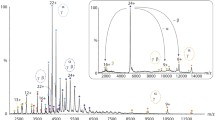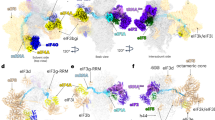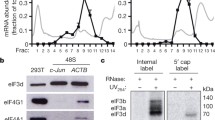Abstract
The initiation of mRNA translation requires the recruitment to the ribosome of the initiator methionyl-tRNA (Met-tRNAi). This is mediated by initiation factor-2 (eIF2), a heterotrimeric protein of subunits α-γ, of which the γ binds guanine nucleotides (Fig. 1). eIF2 can only interact with Met-tRNAi when it is in its GTP-bound form. The GTP molecule is hydrolysed late in the initiation process and eIF2 is released from the ribosome as a complex with GDP, which is inactive in binding Met-tRNAi. To enable eIF2 to participate further in translation initiation, the GDP must be released and replaced by GTP, a process termed guanine nucleotide exchange. The off-rate of GDP bound to eIF2 is very slow, and a protein factor (a guanine nucleotide exchange factor) is required to accelerate this process and facilitate the regeneration of active eIF2-GTP for subsequent rounds of translation initiation. This guanine nucleotide exchange factor is eIF2B (Fig. 1.)
Access this chapter
Tax calculation will be finalised at checkout
Purchases are for personal use only
Preview
Unable to display preview. Download preview PDF.
Similar content being viewed by others
References
Aroor AR, Denslow ND, Singh LP, O’Brien TW, Wahba AJ (1994) Phosphorylation of rabbit reticulocyte guanine nucleotide exchange factor in vivo. Identification of putative casein kinase II phosphorylation sites. Biochemistry 33:3350–3357
Asano K, Krishnamoorthy T, Phan L, Pavitt GD, Hinnebusch AG (1999) Conserved bipartite motifs in yeast eIF5 and eIF2B, GTPase-activating and GDP-GTP exchange factors in translation initiation, mediate binding to their common substrate eIF2. EMBO J 18:1673–1688
Ashe MP, De Long SK, Sachs AB (2000) Glucose depletion rapidly inhibits translation initiation in yeast. Mol Biol Cell 11:833–848
Balendran A, Casamayor A, Deak M, Paterson A, Gaffney P, Currie R, Downes CP, Alessi DR (1999) PDKI acquires PDK2 activity in the presence of a synthetic peptide derived from the carboxyl terminus of PRK2. Curr Biol 9:393–404
Brunn GJ, Williams J, Sabers C, Weiderrecht G, Lawrence JC, Abraham RT (1996) Direct inhibition of the signalling functions of the mammalian target of rapamycin by the phosphoinositide 3-kinase inhibitors, wortmannin and LY294002. EMBO J 15:5256–5267
Campbell LE, Wang X, Proud CG (1999) Nutrients differentially modulate multiple translation factors and their control by insulin. Biochem J 344:433–441
Craddock BL, Proud CG (1996) The α-subunit of mammalian initiation factor eIF-2B is essential for catalytic activity. Biochem Biophys Res Commun 220:843–847
Cross DAE, Alessi DR, Vandenheede JR, McDowell HE, Hundal HS, Cohen P (1994) The inhibition of glycogen synthase kinase-3 by insulin or insulin-like growth factor-1 in the rat skeletal muscle cell line L6 is blocked by wortmannin, but not by rapamycin: evidence that wortmannin blocks activation of the mitogen-activated protein kinase pathway in L6 cells between Ras and Raf. Biochem J 303:21–26
Cross DAE, Alessi DR, Cohen P, Andjelkovich M, Hemmings BA (1995) Inhibition of glycogen synthase kinase-3 by insulin mediated by protein kinase B. Nature 378:785–789
DeGracia DJ, Neumar RW, White BC, Krause GS (1996) Global brain ischemia and reperfusion: modifications in eukaryotic initiation factors associated with inhibition of translation initiation. J Neurochem 67
DeGracia DJ, Sullivan JM, Neumar RW, Alousi SS, Hikade KR, Pittman JE, White BC, Rafols JA, Krause GS (1997) Effect of brain ischemia and reperfusion on the localization of phosphorylated eukaryotic initiation factor 2γ. J Cereb Blood Flow Metab 17:1291–1302
Dent P, Lavoinne A, Nakielny S, Caudwell FB, Watt P, Cohen P (1990) The molecular mechanism By which insulin stimulates glycogen synthesis in mammalian skeletal muscle. Nature 348:302–308
Dholakia IN, Wahba AJ (1988) Phosphorylation of the guanine nucleotide exchange factor from rabbit reticulocytes regulates its activity in polypeptide chain initiation. Proc Natl Acad Sci USA 85:51–54
Dholakia IN, Mueser TC, Woodley CL, Parkhurst LJ, Wahba AJ (1986) The association of NADPH with the guanine nucleotide exchange factor from rabbit reticulocytes: a role of pyridine dinucleotides in eukaryotic polypeptide chain initiation. Proc Natl Acad Sci USA 83:6746–6750
Duncan R, Hershey JW (1984) Heat shock-induced translational alterations in HeLa cells. Initiation factor modifications and the inhibition of translation. J Biol Chem 259:11882–11889
Duncan RF, Hershey JW (1987) Translational repression by chemical inducers of the stress response occurs by different pathways. Arch Biochem Biophys 256:651–661
Duncan RF, Hershey JW (1989) Protein synthesis and protein phosphorylation during heat stress, recovery, and adaptation. J Cell Biol 109:1467–1481
Eldar-Finkelman H, Segar R, Vandenheede JR, Krebs EG (1995) Inactivation of glycogen synthase kinase-3 by epidermal growth factor is mediated by mitogen-activated protein kinase/p90 ribosomal protein kinase signalling pathway in NIH/3T3 cells. J Biol Chem 270:987–990
Fabian JR, Kimball SR, Heinzinger NK, Jefferson LS (1997) Subunit assembly and guanine nucleotide exchange factor activity of eukaryotic initiation factor elF2B subunits expressed in Sf9 cells. J Biol Chem 272:12359–12365
Flynn A, Proud CG (1996) Insulin stimulation of the phosphorylation of initiation factor 4 E is mediated by the MAP kinase pathway. FEBS Lett 389:162–166
Flynn A, Oldfield S, Proud CG (1993) The role of the γ-subunit of initiation factor eIF-2 in initiation complex formation. Biochim Biophys Acta 1174:117–121
Gilligan M, Welsh GI, Flynn A, Bujalska I, Proud CG, Docherty K (1996) Glucose stimulates the activity of the guanine nucleotide-exchange factor eIF-2B in isolated rat islets of Langerhans. J Biol Chem 271:2121–2125
Gross M, Rubino MS (1989) Regulation of eukaryotic initiation factor-2B activity by polyamines and amino acid starvation in rabbit reticulocyte lysate. J Biol Chem 264:21879–21884
Gross M, Rubino MS, Starn TK (1988) Regulation of protein synthesis in rabbit reticulocyte lysate. Glucose 6-phosphate is required to maintain the activity of eukaryotic initiation factor (eIF)- 2B by a mechanism that is independent of the phosphorylation of eIF-2α. J Biol Chem 263:12486–12492
Hannig EM, Hinnebusch AG (1988) Molecular analysis of GCN3, a translational activator of GCN4: evidence for posttranslational control of GCN3 regulatory function. Mol Cell Biol 8:4808–4820
Hinnebusch AG (1997) Translational regulation of GCN4: a window on factors that control initiator-tRNA binding to the ribosome. J Biol Chem 272:21661–21664
Hughes K, Ramakrishna S, Benjamin WB, Woodgett JR (1992) Identification of multifunctional ATP-citrate lyase kinase as the α-isoform of glycogen synthase kinase-3. Biochem J 288:309–314
Jefferson LS, Fabian JR, Kimball SR (1999) Glycogen synthase kinase-3 is the predominant insulinstimulated eukaryotic initiation factor 2B kinase in skeletal muscle. Int J Biochem Cell Biol 31:191–200
Jeffrey IW, Kelly FJ, Duncan RF, Hershey JWB, Pain VM (1990) Effect of starvation and diabetes on the activity of eIF-2 in rat skeletal muscle. Biochimie 72:751–757
Karinch AM, Kimball SR, Vary TC, Jefferson LS (1993) Regulation of eukaryotic initiation factor-2B activity in muscle of diabetic rats. Am J Physiol 264:E101–108
Kimball SR, Jefferson LS (1988) Effect of diabetes on guanine nucleotide exchange factor activityin skeletal muscle and heart. Biochem Biophys Res Commun 156:706–711
Kimball SR, Jefferson LS (1995) Allosteric regulation of eukaryotic initiation factor eIF-2B by adenine nucleotides. Biochem Biophys Res Commun 212:1074–1081
Kimball SR, Vary TC, Jefferson LS (1994) Regulation of protein synthesis by insulin. Annu Rev Physiol 56:321–348
Kimball SR, Fabian JR, Pavitt GD, Hinnebusch AG, Jefferson LS (1998a) Regulation of guanine nucleotide exchange through phosphorylation of eukaryotic initiation factor eIF2α: role of the α- and δ-subunits of eIF2B. J Biol Chem 273:12841–12845
Kimball SR, Horetsky RL, Jefferson LS (1998b) Implication of eIF2B rather than eIF4E in the regulation of global protein synthesis by amino acids in L6 myoblasts. J Biol Chem 273:30945–30953
Kleijn M, Proud CG (2000a) Glucose and amino acids modulate translation factor activation by growth factors in PC12 cells. Biochem J 347:399–406
Kleijn M, Proud CG (2000b) The activation of eukaryotic initiation factor (eIF)2B by growth factors in PC12 cells requires MEK/ERK signalling. FEBS Lett 476:262–265
Kleijn M, Welsh GI, Scheper GC, Voorma HO, Proud CG, Thomas AAM (1998) Nerve and epidermal growth factors induce protein synthesis and eIF2B activation in PC12 cells. J Biol Chem 273:5536–5541
Koonin EV (1995) Multidomain organization of eukaryotic guanine nucleotide exchange factoreIF-2B revealed by analysis of conserved sequence motifs. Protein Sci 4:1608–1617
Oldfield S, Proud CG (1992) Purification, phosphorylation and control of the guanine- nucleotide-exchange factor from rabbit reticulocyte lysates. Eur J Biochem 208:73–81
Pavitt GD, Ramaiah KVA, Kimball SR, Hinnebusch AG (1998) eIF2 independently binds two distinct eIF2B subcomplexes that catalyse and regulate guanine-nucleotide exchange. Genes Dev 12:514–526
Plyte SE, Hughes K, Nikolakaki E, Pulverer BJ, Woodgett JR (1992) Glycogen synthase kinase-3 - functions in oncogenesis and development. Biochim Biophys Acta 1114:147–162
Price NT, Proud CG (1994) The guanine nucleotide-exchange factor, eIF-2B. Biochimie 76:748–760
Price NT, Mellor H, Craddock BL, Flowers KM, Kimball SR, Wilmer T, Jefferson LS, Proud CG (1996) eIF2B, the guanine nucleotide exchange factor for eukaryotic initiation factor-2. Sequence conservation between the α, β and δ subunits of eIF2B from mammals and yeast. Biochem J 318:637–643
Rowlands AG, Panniers R, Henshaw EC (1988a) The catalytic mechanism of guanine nucleotide exchange factor action and competitive inhibition by phosphorylated eukaryotic initiation factor 2. J Biol Chem 263:5526–5533
Rowlands AG, Montine KS, Henshaw EC, Panniers R (1988b) Physiological stresses inhibit guanine-nucleotide-exchange activity in Ehrlich cells. Eur J Biochem 175:93–99
Saito Y, Vandenheede JR, Cohen P (1994) The mechanism by which epidermal growth factor inhibits glycogen synthase kinase-3 in A431 cells. Biochem J 303:27–31
Scheper GC, Mulder J, Kleijn M, Voorma HO, Thomas AAM, van Wijk R (1997) Inactivation of eIF2B and phosphorylation of PHAS-I in heat-shocked rat hepatoma cells. J Biol Chem 272:26850–26856
Singh LP, Wahba AJ (1998) Allosteric activation of rabbit reticulocyte guanine nucleotideexchange factor activity by sugar phosphates and inositol phosphates. Biochem Biophys Res Commun 217:616–623
Singh LP, Aroor AR, Wahba AJ (1994) Phosphorylation ofthe guanine nucleotide exchange factor and eukaryotic initiation factor 2 by casein kinase 2 regulates guanine nucleotide binding and GDP/GTP exchange. Biochemistry 33:9152–9157
Singh LP, Denslow ND, Wahba AJ (1996) Modulation of rabbit reticulocyte guanine nucleotide exchange factor activity by casein kinases 1 and 2 and glycogen synthase kinase 3. Biochemistry 35:3206–3212
Sutherland C, Cohen P (1994) The α-isoform of glycogen synthase kinase-3 from rabbit skeletal muscle is inactivated by p70 S6 kinase or MAP kinase-activated protein kinase-1 in vitro. FEBS Lett 338:37–42
Sutherland C, Leighton IA, Cohen P (1993) Inactivation of glycogen synthase kinase-JP by phosphorylation: new kinase connections in insulin and growth-factor signalling. Biochem J 296:15–19
Thomas G, Hall MN (1998) TOR signalling and the control of cell growth. Curr Opinion Cell Biol 9:782–787
Vanhaesebroeck B, Alessi DR (2000) The P13K-PDKI connection: more than just a road to PKB. Biochem J 346:561–576
Vazquez de Aldana CR, Marton MJ, Hinnebusch AG (1995) GCN20, a novel ATP binding cassette protein, and GCNI reside in a complex that mediates activation of the eIF-2? kinase GCN2 in amino acid starved cells. EMBO J 14:3184–3189
Wang QM, Park IK, Fiol CJ, Roach PJ, DePaoli-Roach AA (1994) Isoform differences in substrate recognition by glycogen synthase kinases 3α and 3β in the phosphorylation of phosphatase inhibitor 2. Biochemistry 33:143–147
Wang X, Flynn A, Waskiewicz AJ, Webb BLJ, Vries RG, Baines IA, Cooper J, Proud CG (1998) The phosphorylation of eukaryotic initiation factor eIF4E in response to phorbol esters, cell stresses and cytokines is mediated by distinct MAP kinase pathways. J Biol Chem 273:9373–9377
Webb BLJ, Proud CG (1998) Eukaryotic initiation factor 2B (eIF2B). Int J Biochem Cell Biol 29:1127–1131
Welsh GI, Proud CG (1992) Regulation of protein synthesis in Swiss 3T3 fibroblasts. Rapid activation of the guanine-nucleotide-exchange factor by insulin and growth factors. Biochem J 284:19–23
Welsh GI, Proud CG (1993) Glycogen synthase kinase-3 is rapidly inactivated in response to insulin and phosphorylates eukaryotic initiation factor eIF-2B. Biochem J 294:625–629
Welsh GI, Foulstone EJ, Young SW, Tavare JM, Proud CG (1994) Wortmannin inhibits the effects of insulin and serum on the activities of glycogen synthase kinase-3 and mitogen-activated protein kinase. Biochem J 303:15–20
Welsh GI, Miyamoto S, Proud CG, Safer B (1996) T-cell activation leads to rapid stimulation of translation initiation factor eIF-2B and inactivation of glycogen synthase kinase-3. J Biol Chem 271:11410–11413
Welsh GI, Stokes CM, Wang X, Sakaue H, Ogawa W, Kasuga M, Proud CG (1997) Activation of translation initiation factor eIF2B by insulin requires phosphatidylinositoI3-kinase. FEBS Lett 410:418–422
Welsh GI, Miller CM, Loughlin AJ, Price NT, Proud CG (1998) Regulation of eukaryotic initiation factor eIF2B: glycogen synthase kinase-3 phosphorylates a conserved serine which undergoes dephosphorylation in response to insulin. FEBS Lett 421:125–130
Williams DD, Marin O, Pinna LA, Proud CG (1999) Phosphorylated seryl and threonyl, but not tyrosyl, residues are efficient specificity determinants for GSK-3 and Shaggy. FEBS Lett 448:86–90
Williams DD, Pavitt GD, Proud CG (2001) Characterisation of initiation factor eIF2B and its regulation in Drosophila melanogaster. J Biol Chem 276:3733–3742
Woods YL, Cohen P, Becker W, Jakes R, Goedert M, Wang X, Proud CG (2001) The kinase DYRK phosphorylates protein synthesis initiation factor eIF2BE at Ser539 and the microtubule-associated protein Tau at Thr212: potential role for DYRK as a glycogen-synthase kinase 3- priming kinase. Biochem J In press
Yang W, Hinnebusch AG (1996) Identification of a regulatory subcomplex in the guanine nucleotide exchange factor eIF2B that mediates inhibition by phosphorylated eIF2. Mol Cell Biol 16:6603–6616
Yang R, Wek SA, Wek RC (2000) Glucose limitation induces GCN4 translation by activation of Gcn2 protein kinase. Mol Cell Biol 20:2706–2717
Author information
Authors and Affiliations
Editor information
Editors and Affiliations
Rights and permissions
Copyright information
© 2001 Springer-Verlag Berlin Heidelberg
About this chapter
Cite this chapter
Proud, C.G. (2001). Regulation of Eukaryotic Initiation Factor eIF2B. In: Rhoads, R.E. (eds) Signaling Pathways for Translation. Progress in Molecular and Subcellular Biology, vol 26. Springer, Berlin, Heidelberg. https://doi.org/10.1007/978-3-642-56688-2_4
Download citation
DOI: https://doi.org/10.1007/978-3-642-56688-2_4
Publisher Name: Springer, Berlin, Heidelberg
Print ISBN: 978-3-642-62589-3
Online ISBN: 978-3-642-56688-2
eBook Packages: Springer Book Archive




